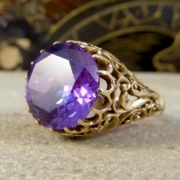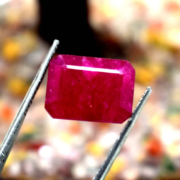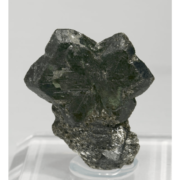Alexandrite: Properties, Uses and Virtues
Alexandrite: A chameleon gem!
The fascinating world of alexandrite, a rare and bewitching gem that will captivate your imagination with its unique beauty and magical property of color change. This precious stone, a member of the chrysoberyl family, is distinguished by its astonishing ability to display different hues depending on the light source to which it is exposed.
Alexandrite: Table of contents
- Alexandrite Geological Formation
- Sources – The Worldwide Reach of the Alexandrite
- Historical Significance of the Alexandrite – Through the Ages
- Metaphysical Properties of Alexandrite – Illuminating energies
- Alexandrite Varieties
- Alexandrite Colors
- Alexandrite’s durability and Wearability
- Alexandrite Enhancements – Preserving Natural Beauty
- Alexandrite Synthétique – Nature in the Laboratory
- Imitations of the Alexandrite – Discerning the Authentic
- Alexandrite care – Preserving natural beauty
Alexandrite Geological Formation
Alexandrite, a bewitching chameleon gem belonging to the chrysoberyl family, forms in specific conditions in metamorphic rocks and pegmatites. These high-temperature, high-pressure environments provide ideal conditions for gem creation. The presence of chromium in these rocks gives alexandrite its captivating property of changing color under different light sources.
Sources – The Worldwide Reach of the Alexandrite
Originally discovered in the Ural Mountains of Russia in 1830, alexandrite’s rare color-changing properties have created a sensation in the gem world. While Russia was historically the main source, Brazil is now the most important supplier of this enchanting gem. Brazilian alexandrite deposits produce substantial quantities of this elusive chameleon gem. Other notable sources are Sri Lanka, which produces large stones, and India, Zimbabwe and Zambia, which produce smaller gems.
Historical Significance of the Alexandrite – Through the Ages
Named after Tsar Alexander II of Russia, Alexandrite has become Russia’s national stone. Its discovery in the early 19th century aroused fascination because of its unique color-changing property.
In daylight, the gem appears blue-green to green, changing to a reddish-purple or reddish-violet hue under incandescent lighting.
Highly sought-after by the Russian aristocracy, alexandrite adorned jewelry of the period.
Metaphysical Properties of Alexandrite – Illuminating energies
Alexandrite is associated with mystery and magic. Believed to bring good luck, enhance intuition and stimulate creativity, this gem is considered an emotional balancing stone. It promotes inner harmony and self-confidence, encouraging joy and a positive outlook on life. In recent years, it has become widely accepted as one of June’s birthstones along with pearls.
Alexandrite Varieties
As a member of the chrysoberyl family, alexandrite shares characteristics with other chrysoberyl gems. However, its most distinctive feature is its remarkable ability to change color under different lighting conditions. While the color change variety is renowned, cat’s eye and transparent chrysoberyl are also available.
Alexandrite Colors
The unique characteristic of alexandrite is its color change, known as the “alexandrite effect”.
In natural light, the gem presents a vivid green or blue-green hue, transforming into a captivating red-violet or raspberry hue under artificial light.
The interaction between chrome and surrounding light sources creates this spellbinding phenomenon.
Alexandrite’s durability and Wearability
With a remarkable hardness of 8.5 on the Mohs scale, alexandrite is highly durable and scratch-resistant. Its resilience enables it to withstand daily wear, making it suitable for a variety of jewelry, including rings and pendants.
Despite its durability, due to its rarity and value, it is advisable to handle alexandrite jewelry with care to avoid accidental damage.
Alexandrite Enhancements – Preserving Natural Beauty
The color-change property of natural alexandrite is highly appreciated, limiting the need for treatments or enhancements.
Some gem dealers may try to improve the color of lower-grade alexandrite by heating, but such treatments are rare and should be disclosed to buyers.
Alexandrite Synthétique – Nature in the Laboratory
Due to the scarcity of natural alexandrite, synthetic alternatives, also known as laboratory-grown alexandrite, have been created.
These synthetic gems have the same physical properties and color changes as their natural counterparts.
Be careful, even when looking for synthetic alexandrite, because it’s often color-change synthetic sapphire!
Imitations of the Alexandrite – Discerning the Authentic
As a precious gem, alexandrite is sometimes imitated or misrepresented on the market. Unscrupulous sellers may try to pass off other gemstones or synthetic materials as alexandrite, such as synthetic color-change sapphires, spinels and garnets. Buyers should be cautious and purchase alexandrite from reputable and certified gem dealers to guarantee its authenticity.
Alexandrite care – Preserving natural beauty
Proper care is essential to preserve the beauty and value of alexandrite jewelry.
Avoid exposing them to aggressive chemicals, extreme temperatures or sudden temperature changes.
Clean alexandrite jewelry with a soft brush and mild soapy water, rinse thoroughly and dry with a soft cloth.
For more thorough cleaning, mechanical methods such as ultrasound or steam can be used, but avoid excessive force or abrasive substances.
Store alexandrite jewelry separately to avoid scratches and damage.



Leave a Reply
Want to join the discussion?Feel free to contribute!